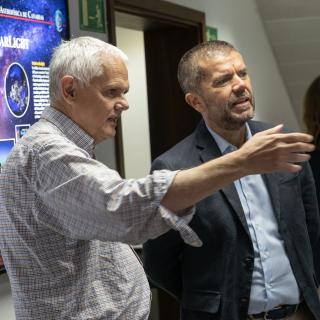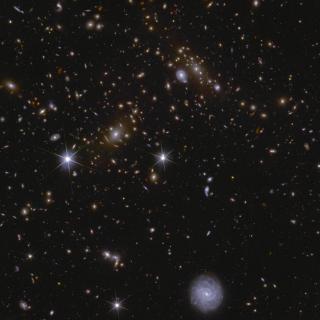It may interest you
-
 Una delegación de la Universidad de La Laguna (ULL), encabezada por el rector Francisco García, ha realizado una visita institucional al Instituto de Astrofísica de Canarias (IAC), reforzando así el compromiso de colaboración y la estrecha relación que mantienen ambas instituciones, claves para el desarrollo científico y tecnológico de Canarias. El encuentro ha servido para revisar el estado del convenio que mantienen ambas instituciones y revisar algunas áreas de mejora para la renovación del mismo en materia de investigación, docencia y divulgación científica, además de aspectosAdvertised on
Una delegación de la Universidad de La Laguna (ULL), encabezada por el rector Francisco García, ha realizado una visita institucional al Instituto de Astrofísica de Canarias (IAC), reforzando así el compromiso de colaboración y la estrecha relación que mantienen ambas instituciones, claves para el desarrollo científico y tecnológico de Canarias. El encuentro ha servido para revisar el estado del convenio que mantienen ambas instituciones y revisar algunas áreas de mejora para la renovación del mismo en materia de investigación, docencia y divulgación científica, además de aspectosAdvertised on -
 The European Space Agency’s Euclid mission released its first batch of survey data, including a preview of its deep fields. Using Artificial Intelligence (AI) algorithms in combination with citizen science campaigns, the Euclid Consortium scientific results include the discovery of strong gravitational lensing systems, the exploration of galaxy clusters and the cosmic web, the characterisation of active galactic nuclei (AGN) and quasars, studies on galaxy evolution and morphology, and the identification of numerous dwarf galaxies and transients. Spain has an important role in the EuclidAdvertised on
The European Space Agency’s Euclid mission released its first batch of survey data, including a preview of its deep fields. Using Artificial Intelligence (AI) algorithms in combination with citizen science campaigns, the Euclid Consortium scientific results include the discovery of strong gravitational lensing systems, the exploration of galaxy clusters and the cosmic web, the characterisation of active galactic nuclei (AGN) and quasars, studies on galaxy evolution and morphology, and the identification of numerous dwarf galaxies and transients. Spain has an important role in the EuclidAdvertised on -
 The Instituto de Astrofísica de Canarias (IAC) has been honoured with the Canary Islands Diamond Award in the category of Business and Economic Innovation, a distinction granted by Canal 4 Tenerife as part of the first edition of these awards on the occasion of its 30th anniversary. The recognition is bestowed “in acknowledgement of its scientific excellence and its international projection from the Canary Islands” and highlights the IAC’s contribution to the development of a knowledge-based economy in the Archipelago. The IAC was selected as the winner following a jury evaluation processAdvertised on
The Instituto de Astrofísica de Canarias (IAC) has been honoured with the Canary Islands Diamond Award in the category of Business and Economic Innovation, a distinction granted by Canal 4 Tenerife as part of the first edition of these awards on the occasion of its 30th anniversary. The recognition is bestowed “in acknowledgement of its scientific excellence and its international projection from the Canary Islands” and highlights the IAC’s contribution to the development of a knowledge-based economy in the Archipelago. The IAC was selected as the winner following a jury evaluation processAdvertised on
